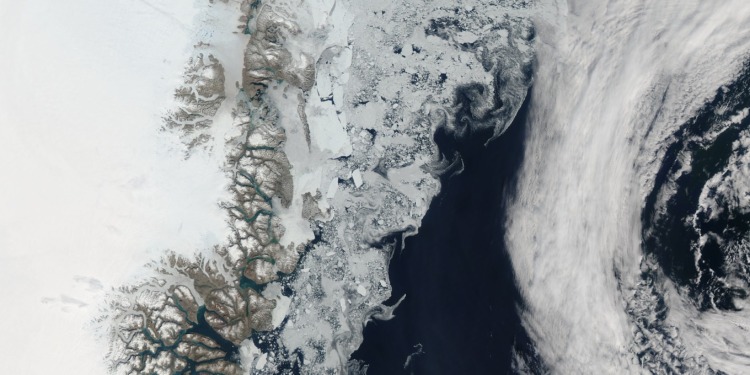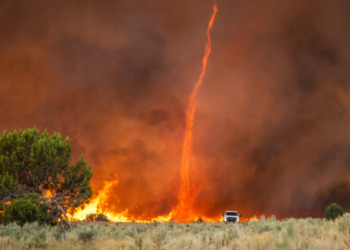In the face of escalating climate concerns and growing eco-anxiety among new generations, climate deniers often resort to dismissive rhetoric, trivializing the gravity of climate change.
Rather than acknowledging the urgent need for action, among the widespread misconceptions, they attempt to justify rising temperatures and extreme weather events by attributing them to so-called “natural climate cycles.”
But what are these cycles, and can they truly explain the complexities of climate change? While some deniers may lack essential knowledge, the scientific evidence unequivocally demonstrates that climate change extends far beyond mere natural cycles.
It was just a few days ago, on July 30, during the annual League summer celebration that once again this dismissive attitude was exemplified by politician Matteo Salvini, the leader of the Lega party in Italy. No doubt, he was echoing his US conservative colleague, the Florida Republican Governor Ron de Santis’ full-out war on ESG investing.
During the Lega Romagna event, Salvini responded to a question about an episode that happened a few days earlier at the Giffoni Film Festival where a girl, admitting to having eco-anxiety and not knowing if she wanted “to have children in a world so at risk,” asked the Minister for the Environment and Energy Security, Gilberto Pichetto Fratin if he too wasn’t afraid of the future; the latter then responded with emotion: “I have the strength of doubt, I have a duty towards the office I hold towards you and towards my grandchildren.”
Although even Minister Fratin’s response does not really reflect that of a minister who should actively work for an ecological transition of the country and more than “doubts” seek certainties, the response of the League leader when asked to comment on the episode is even more worrying.
Salvini responded by reducing the girl’s concerns to a simple weather observation: “It’s hot, undoubtedly in the summer it’s hot and in the winter it’s cold.”
He went on to dismiss her worries about retreating glaciers and instead proudly stated that all you have to do is “study a little bit of history and you see that they are cycles.”
Such responses not only downplay the severity of climate change but also undermine the genuine anxieties felt by many about their future in an increasingly uncertain world.
Along with this idea, it is often suggested that climate change is just part of the Earth’s natural rhythm, that there have been many cycles of hot and cold weather in the past or it is claimed that climate models are unreliable and exaggeratedly sensitive to carbon dioxide.
These arguments are not only misleading but also undermine the tireless efforts of thousands of scientists worldwide who have come together to study and address climate change.
We need to understand the magnitude of the work done so far by climate scientists. For the past 30 years, they have come together in the UNFCC panel – over a thousand scientists from every corner of the earth. And UNFCC annual reports on the state of the climate are the result of consensual work, in other words, they all agree on the conclusions.
Unquestionably, there are also some climate deniers among scientists. But over time, they have become fewer and many have abandoned their previous anti-climate change stance. Today, overall, there is less than three-to-five percent of the scientific community that still clings to climate denial.
Going beyond the opinions of climate scientists, it is crucial to debunk the fallacy that natural climate cycles can explain away the unprecedented changes we are witnessing today.
So, what are these natural cycles….
Amidst the complexities of Earth’s climate, natural cyclical variations have played a pivotal role in shaping the planet’s long-term weather patterns.
These natural cycles occur at various time scales, from short-term variations to the multi-millennial Milankovitch cycles, named after Serbian scientist Milutin Milankovitch.
These cycles arise from changes in Earth’s position relative to the Sun, inducing variations in solar radiation received on the Earth’s surface and influencing climate over thousands of years.
The Milankovitch cycles encompass three key orbital movements: eccentricity, obliquity, and precession.
First, eccentricity refers to the shape of Earth’s orbit, which changes from more circular to more elliptical over time. Second, obliquity denotes the tilt of Earth’s axis with respect to its orbital plane, causing the angle of sunlight to fluctuate. Third, precession refers to the slow wobble in Earth’s rotational axis, altering the orientation of Earth’s axis of rotation.
These cyclical orbital movements lead to variations in the amount of solar radiation reaching Earth’s mid-latitudes, varying by up to 25 percent.
While these changes in solar radiation alone are not potent enough to cause significant temperature shifts, they trigger vital feedback mechanisms that amplify the effects.
One of these mechanisms involves changes in global surface reflectivity, known as albedo. Slight increases in solar radiation at northern latitudes lead to ice melt, reducing the amount of sunlight reflected by ice surfaces and thus increasing overall warming.
Another critical feedback mechanism involves atmospheric greenhouse gas concentrations, such as carbon dioxide. The slight warming caused by orbital changes warms oceans, releasing carbon dioxide into the atmosphere, which, in turn, amplifies warming effects.
….And are they really what is behind the warming of the Earth?
While Earth’s climate has experienced fluctuations over millennia, what is clear however, is that the scientific proof in the realm of climate cycles leaves no room for imagination, climate change is much more than this.
The current trends of rapid temperature rise and extreme weather events go beyond anything observed in history.
The scientific community has amassed substantial evidence indicating that human activities, particularly the release of greenhouse gasses into the atmosphere, are the primary drivers of modern climate change.
While Milankovitch cycles have played a role in Earth’s historical climate variations, they cannot account for the rapid warming observed since the pre-Industrial era. They operate on long time scales, spanning tens to hundreds of thousands of years, whereas Earth’s recent warming has occurred over decades to centuries.
Related Articles: Clearing up Common Misconceptions on Climate Change | Climate Change Doesn’t Have Time for Broken Two-Party Politics | Climate Anxiety Exacerbated by Lack of Access to Nature | How to Talk to a Climate Denier | Why Right Wing Populism Is Unable To Address the Climate Crisis
Scientists are unequivocal in their conviction that “ climate-warming trends over the past century are extremely likely due to human activities,” particularly the release of carbon dioxide from burning fossil fuels.
Observations show that solar radiation has not changed significantly over the last 150 years, dismissing Milankovitch cycles as the driving force behind the modern temperature surge.
Furthermore, climate change results from various factors, and Milankovitch cycles are just one piece of the puzzle.
Past Ice Age cycles saw significant temperature fluctuations influenced not only by ice sheet extent but also by fluctuations in atmospheric carbon dioxide levels.
Climate models confirm that human-induced carbon dioxide emissions have overwhelmed any potential forcing from Milankovitch cycles.
The global average temperature has risen over 1 degree Celsius since 1850, and recent assessments project a further half-degree Celsius increase by 2030 due to human activities. The current rate of global warming is over 50 times greater than any slight extra warming that could be attributed to changes in incoming solar radiation.
Additionally, Earth is currently in an interglacial period, which, according to Milankovitch cycles, should result in cooling rather than the observed warming trend.
In conclusion, the scientific evidence overwhelmingly supports the assertion that current climate change is a man-made catastrophe.
But then how can people still use them to defend their actions?
Milankovitch cycles are clearly an insufficient explanation for the rapid warming occurring since the Industrial Age. Consequently, the burning of fossil fuels and subsequent increase in carbon dioxide concentration are the primary drivers of the present climate crisis, demanding urgent action to mitigate its potentially devastating consequences.
The tactic used by climate deniers to shift the attention towards these cycles, is certainly not new, but somehow continues to resonate. Despite the overwhelming evidence supporting human-induced climate change, influential figures, especially right-wing politicians, just like Salvini and Ron de Santis, continue to spread misinformation.
Whether climate deniers use such explanations when questioned about climate change because they actually don’t have the basic knowledge and are simply “victims” that can be “guided” out of their misconception is a possibility, or maybe not.
In any case, their refusal to acknowledge the severity of the crisis and embrace meaningful action impedes progress in tackling this global challenge .
It is time for society to see through these attempts to obfuscate the truth and hold those in power accountable for their actions or inaction in safeguarding our planet and future generations.
As we grapple with the realities of climate change, we must not belittle the concerns of those who suffer from eco-anxiety and genuine fear for their future.
Climate change is not merely a matter of hot summers and cold winters. It poses profound and far-reaching consequences – from floods that could wipe out coastal towns to droughts that destroy agriculture, both are likely to cause unprecedented migration movements and deaths. Such threats are very real and demand our collective attention and action.
Editor’s Note: The opinions expressed here by the authors are their own, not those of Impakter.com — In the Featured Photo: Ice moves and melts in the Arctic waters . Featured Photo Credit: NASA/GSFC/Jeff Schmaltz/MODIS Land Rapid Response Team.










